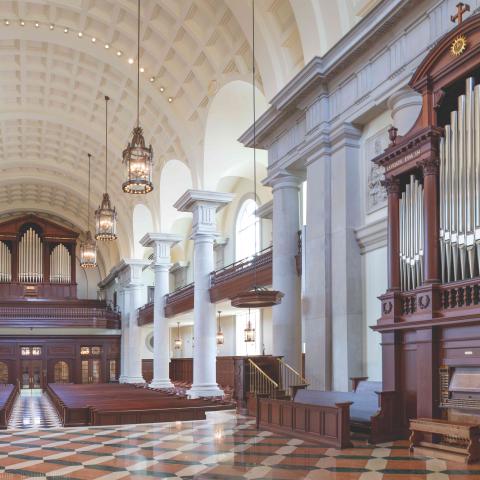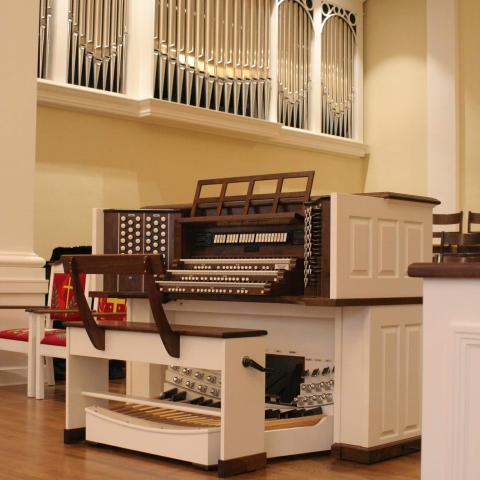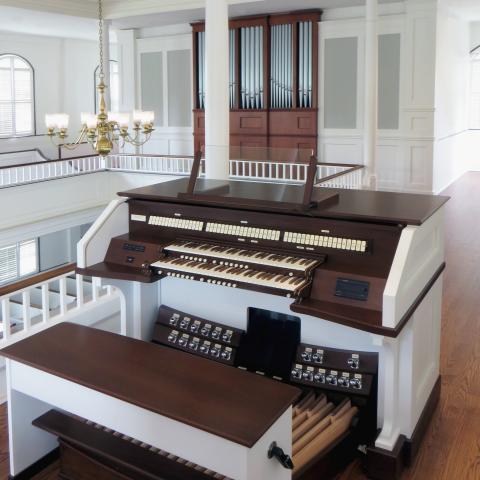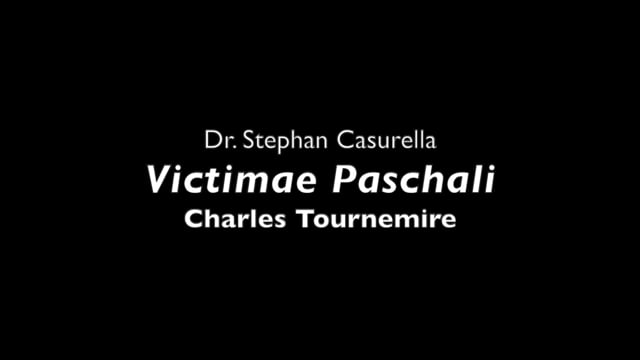Richards, Fowkes & Co., Ooltewah, Tennessee; Christ Church Cathedral, Cincinnati, Ohio

Background
While some organ projects come together quickly, most usually take longer. And some, such as our recently completed Opus 24 for Christ Church Cathedral in Cincinnati, seem to require almost a micro-generation to fulfill. For those who are patient, this duration can pay dividends. After all, relationships take time to build, not merely between people or groups, but also between the creative act itself and the space in which it has been asked to flourish. Christ Church is a complicated space with an involved history; our becoming part of it was never likely to be straightforward.
Christ Church was founded in 1817 and soon settled into an 1835 building that would last through World War II. The Gothic revival Centennial Chapel, added in 1917, has its own organ history, which has culminated in C. B. Fisk’s Opus 148 in an Italian style, completed in 2018 (see The Diapason August 2018 cover feature). Although by the 1930s the main church was thought to be in need of replacement, World War II paused any rebuilding effort. After a proposed design by Eliel and Eero Saarinen was rejected, Ohio architect David Briggs Maxfield’s modern design was chosen, and the new building was dedicated in 1957. In 1993, Christ Church was consecrated as Cathedral of the Diocese of Southern Ohio.
Walter Holtkamp, Sr.’s three-manual, 54-stop organ was a logical fit for this new mid-century modern building. His daring unencased sculptural design fit perfectly with the building’s architectural aesthetic. Holtkamp’s clean, “classic” voicing style won many admirers, and this organ helped launch Gerre Hancock’s early career as well as being a central part of Christ Church’s annual Boar’s Head and Yule Log Festival.
While the Holtkamp was well regarded, musicians struggled with certain aspects of the organ’s personality. Over the years, consultants attempted to diagnose the situation and offer suggestions. The consensus was that the organ’s location was a key detriment. Located in a shallow open gallery on the left, the Holtkamp spoke across the chancel and engaged the acoustic in such a way as to generate a confusing flutter echo.
In the early 1980s, the church was renovated and largely stripped of decoration. The stone east-facing altar was replaced by a wooden table, and other surfaces altered to help absorb troubling reflections. Unfortunately, these alterations exacerbated rather than alleviated the acoustical issues. In less than a decade, another renovation was in the works, this time to warm up the room visually and suggest more of a traditional aesthetic. Wooden galleries were added to the organ loft, together with pilasters and wooden coffer beams to break up and articulate the walls and ceiling. The climax of this effort was a wood-and-glass chancel screen directly behind the choir. Although successful from a liturgical standpoint, the new wall tended to swallow up the organ’s modest bass (as well as that of the choir), further altering the balance of the Holtkamp.
The effect on choral singing was detrimental. While the choir was now front and center, ostensibly a good thing, the location put the singers farther than ever from the Holtkamp’s enclosed divisions. Without any nearby surfaces for early reflections, singers struggled to hear not only each other but the organ. A common accompanimental conundrum ensued: if the organist could hear the instrument, it almost always meant the organ was too loud to balance the choir. After much discussion about the merits of moving divisions, and possibly revoicing, it was concluded that any such radical changes would spoil the Holtkamp. For an organ to succeed, it needed a central placement, engaging the room not side to side, but fully down the length of the nave.
Process
The cathedral first contacted us in July 2008. James Diamond, the cathedral’s former and now late dean, had called a committee (himself, Robert Clark, Roberta Gary, Thom Miles) to assess the Holtkamp and make recommendations either for its rebuilding or replacement. In retrospect, this was merely the first of what would turn out to be this project’s three phases.
When this first committee finished its work, the assumption was that the dean would accept the committee’s recommendation, seek funding, and sign a contract. But July 2008 became September 2008. The ensuing financial crisis and Great Recession caused the project to be shelved.
When Stephan Casurella was appointed director of music in 2009, he was asked to begin the process anew with the current music committee chaired by cathedral member and Cincinnati Symphony Orchestra violinist Harold Byers. Dean Diamond did suggest, however, that Stephan visit our organs at Pinnacle Presbyterian Church in Scottsdale, Arizona, and Church of the Transfiguration in Dallas, Texas. In time, we were again selected again to build a new organ. In 2010, the new interim dean and the music committee took the project to the vestry, led by senior warden Mary Hagner, a chorister since childhood; but the timing was still not right.
In 2013, with the arrival of a new dean, Gail Greenwell, all of the factors were finally in place for a successful outcome. After five years of planning and education they were ready to sign a contract.
The case for Deco
Designing a beautiful and sensible case proved formidable. The twice-rebuilt church now had an identity issue: well thought out and tasteful, yes, but not necessarily in any strong style. Focus on both altar and cross seemed diffuse. We believed that the right organ design could tie everything together, but how?
Our first two designs were in a classic style. We soon came to see that this incongruity—which has worked for us elsewhere—would not be the answer here. Eventually, Ralph Richards and Trent Buhr started working with the arch curve at the front of the nave. Using this motif, they outlined the overall organ and its undulating cross section. The arch was then scaled, flipped, and stacked to subdivide the compartments. As the instrument began to emerge, Trent observed that the design was taking on Art Deco elements. After many hours of study, trial and error, and, to everyone’s surprise, exploring Art Deco as a style allowed us to fuse the room and the case into a single concept. In a nod to fractal theory even the decoration contains the same hockey stick motif applied to the six Hebrew letters of the word Hallelujah. An unintended consequence is an addition to the prominent legacy of Art Deco in Cincinnati.
The tonal landscape
Ralph and I started building organs in the 1970s, when the early music movement and historic tradition were just coming into bloom in the United States. Over the last thirty-three years, our team of eleven artisans has built organs using all of the knowledge that has come from the last century of organ methodology. Thus begins a litany that may seem familiar from builders of our general type but is far from a list of “features” to us. Wherever our tonal style may take us, certain fundamentals remain resolute. Our instruments are built in cases made from solid wood using traditional joinery methods and finishes. Suspended mechanical key actions provide the most intimate connection we can offer between the keys and the pipes. Wooden wind systems with large wedge bellows (in this instrument, five 4′ x 8′ bellows) and generous wind trunks allow a system that breathes as should a real wind instrument.
Pipe making is our point of pride. Our metal pipes are handmade from sheets cast using historically informed metal alloys. The sheets are then hand-planed to taper the thickness of every pipe. This allows the foot and mouth area to be made thickest, for strength, with the bodies lessening in thickness towards the top of the pipe, to ensure that the weight of pipes will not lead to collapse at mouth or toe. We make every pipe in our shop.
Most of our instruments are based in the classic North German and Dutch traditions, noted for exceptionally colorful instruments that excel at leading congregations. But, over those thirty-three years, it has become clearer to us that we live neither in Germany nor Holland, nor in some other century. We are building American organs for American churches of the twenty-first century. The people of today, even when they share our love of the old instruments and music, have ideas about singing and accompaniment that lie well away from any Germanic centrality, and which our organs cannot consider mere inconveniences if they are to succeed. Episcopalians ourselves, we are more and more wanting our organs to reflect this blended landscape.
When we were selected at St. George’s Hanover Square in London, the musician Simon Williams asked for an organ that could accompany an English choir yet still play Buxtehude authentically. Frankly, we felt we had begun to do just that in our Scottsdale instrument, not by tempering the ensemble, but rather by filling out the organ’s quiet end with open flutes and strings. At the same time, we wanted those quieter voices to have plenty of color and personality. Better expression played its part. Double paneling in the swell boxes, combined with thick shutters, provides a wider dynamic range. As time has gone on, we have made other decisions about how much articulation is appropriate, or even musically helpful. Voicing our pipes a little slower relaxes the speech and helps them blend better. London was also our first organ with two enclosed divisions. Since then we have built one other large organ with a second enclosed manual, further exploring this quiet, but hopefully alluring, sound world.
When J. S. Bach was advising Zacharias Hildebrandt for the organ at Saint Wenzel in Naumburg, he recommended that all flutes of a particular construction exist on the same keyboard, so that one could immediately tell the difference between different manuals. At Christ Church, we have done likewise. The Positive flutes are all built from open, tapered pipes, as are the quieter flutes and strings. The Great flutes are open, while the Swell flutes are stopped. (True, the Swell’s 4′ Flöht traverse lives here and is voiced to blend and act in a generally nineteenth-century manner.)
Throughout, the strings are of Germanic inspiration. Voiced with less garlic than French strings, the German type have a light, bright tone that allows them to work effectively in many styles of literature. (When voicing these strings, we are not doctrinaire and happily use modern roller beards to stabilize speech.) The Great Salicional is the largest in scale and finds its double in the Pedal Violonbaß. The Swell strings are a medium scale, voiced in the brightest manner, thinking again of how nineteenth- and twentieth-century literature expects that kind of effect in that location. The Positive’s are the smallest, tapered and of 90% tin, voiced chastely. As a result, they have an ethereal edge and lack of body that, with the 4′ Viol, make psalm accompaniment an organist’s dream.
An unusual feature is that at eighteen stops, the Positive division is the largest of the three. The 8′ Principal and Trompette-en-Chamade are unenclosed, the latter located horizontally above the Positive box for easy dialogue with Swell or Great. With this division low in the case, the Positive has proven to be the accompaniment workhorse, especially during Covid when only eight singers were allowed.
Like the strings, the reeds are mostly of German origin. The Pedal and Great reeds are patterned after Schnitger, while the Swell Trompet and Oboe are influenced by central German stops, which, like French reeds, employ cylindrical shallots. We use our own bass shallot pattern here, with tin-plated tapered forms, which helps to keep the basses from outshouting the trebles. The Chamade has French-type parallel shallots, which are wonderfully flexible and permit voicing on the round side. (After all, we wouldn’t want the French stop to feel as if it were being occupied by the Germans.) Also Germanic, in a way, is the completely independent Pedal, from 32′ to mixture. Six independent 16′ stops (four flue and two reed stops) provide variety and foundation for infinite gradations of color and volume.
Organ builders usually wince when we read in the magazines, “We were given the task to build an organ that would play all of the organ literature authentically and accompany 400 years of choral anthems seamlessly.” The unity of this organ, we hope, comes from the fact that we are, yes, historically informed about the different schools and eras of organ building. But our evolving confidence about those schools has made us freer to meld those ideas into a voice of our thoughts, our tastes, and our sensibilities—and, hopefully, of our time.
Richards, Fowkes & Co.
Jakob Barger
Trent Buhr
Patrick Fischer
Bruce Fowkes
Karla Fowkes
Nathan Govig
Alex Haas
Joshua Knight
Richard Mcusic
Brian Miscio
Jesse Mozzini
Ralph Richards
Richard Schulze
Patrick Spiesser
Dean Wilson
Andy Wishart
Stephan Casurella, Canon Precentor & Director of Music
Shiloh Roby, Associate Director of Music
Organ Committee Chair: Julie Kline
Music Committee Chair: Harold Byers/Drew Abbott
Builder’s website:
https://www.richardsfowkes.com/
Church’s website:
https://cincinnaticathedral.com/
GREAT (manual II)
16′ Principal (in façade) 58 pipes
8′ Octave 58 pipes
8′ Spielflöht 58 pipes
8′ Salicional 58 pipes
4′ Octave 58 pipes
4′ Flöht 58 pipes
3′ Quint 58 pipes
2′ Octave 58 pipes
Cornet IV (Tenor A, 4′, 3′, 2′, 1-3⁄5′) 141 pipes
1-1⁄3′ Mixture 264/324 pipes
16′ Trompet 58 pipes
8′ Trompet 58 pipes
POSITIVE (manual I, enclosed)
8′ Principal (façade) 58 pipes
8′ Hohlflöht 58 pipes
8′ Quintadena 58 pipes
8′ Flöht dolce 58 pipes
8′ Flöht celeste (TC) 46 pipes
8′ Dulcet 58 pipes
8′ Dulcet celeste (TC) 46 pipes
4′ Octave 58 pipes
4′ Viol 58 pipes
4′ Spitzflöht 58 pipes
3′ Nasat 58 pipes
2′ Octave 58 pipes
Sesquialtera II 109 pipes
1-1⁄3′ Scharff 204/300 pipes
8′ Krummhorn 58 pipes
8′ Vox humana 58 pipes
4′ Schalmey 58 pipes
8′ Chamade (52–58, 8′ + 3′) 65 pipes
SWELL (manual III, enclosed)
16′ Bourdon 58 pipes
8′ Principal 58 pipes
8′ Gamba 58 pipes
8′ Celeste (TC) 46 pipes
8′ Rohrflöht 58 pipes
4′ Octave 58 pipes
4′ Traverse flöht 58 pipes
3′ Nasat 58 pipes
2′ Waldflöht 58 pipes
1-3⁄5′ Tertia (1–51) 51 pipes
Mixture 232 pipes
16′ Basson 58 pipes
8′ Trompet 58 pipes
8′ Oboe 58 pipes
PEDAL
32′ Subbaß (ext 16′) 12 pipes
16′ Principalbaß 30 pipes
16′ Subbaß 30 pipes
16′ Bourdon (Sw)
16′ Violonbaß 30 pipes
8′ Octave 30 pipes
8′ Spitzflöht 30 pipes
8′ Gedackt (Sw)
4′ Octave 30 pipes
2′ Mixture 120/150 pipes
32′ Posaune (ext 16′) 12 pipes
16′ Posaune 30 pipes
16′ Fagott 30 pipes
8′ Trompet 30 pipes
8′ Trompette (Pos Chamade)
4′ Trompet 30 pipes
Normal couplers
Tremulant to the entire organ
Stable/Flexible Wind switch
Mixture + to add additional high-pitched ranks
Cimbelstern
Vogelgesang
Temperament: Neidhardt for a small city 1732
59 stops
78 ranks (depends on count of compound stops)
3,806 total pipes
When each mixture stop is pulled it turns on the “normal” ranks indicated in black. When the Mixture + knob is pulled it turns on the additional ranks indicated in red in all mixtures. This allows the mixtures to function as “normal” mixtures or as North German mixtures.






